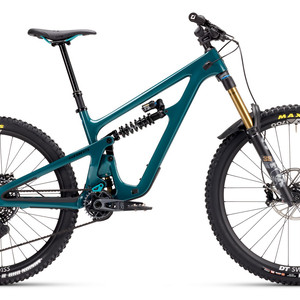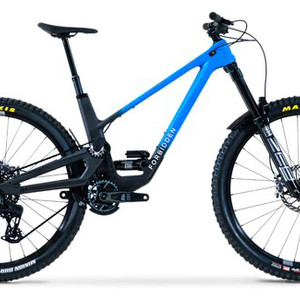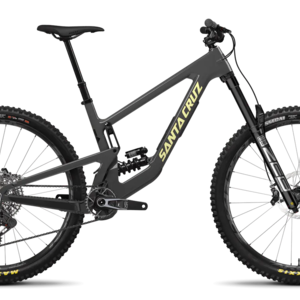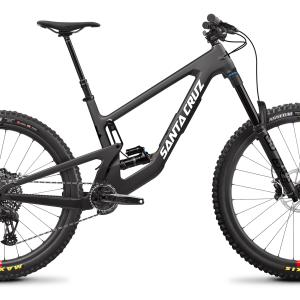2022 Norco Range C1 Bike
(discontinued)
| Where To Buy | |||
|---|---|---|---|
Free shipping on orders over $50 (continental U.S. only).
International shipping available. Some exclusions apply. |
Free shipping on orders over $50 (continental U.S. only).
International shipping available. Some exclusions apply. $9,699.00
|
||
Norco Range C1 Mountain Bike
$9,699.00
|
|||
Free shipping on orders over $50 (continental U.S. only).
International shipping available. Some exclusions apply. |
|||

With the last update to Norco’s long-travel 29er being back in 2018, the all-new 2022 Range is a bike that should excite those with a focus on flat-out speed. After Vital's First Look with the new Range, it became clear this is a massive departure from previous year's models with a full redesign from the ground up. The new Range is the first official bike launched under Norco’s new brand image. The long-travel 29er now features a high, virtual pivot suspension layout with updated geo aimed at inspiring confidence when smashing into the unknown. With the level of anticipation around this bike during its last three years of development, we were happy to finally throw a leg over it and see if the hype is real.
Highlights
- Carbon Fiber frame
- 29-inch wheels
- 170mm (6.7-inches) of rear-wheel travel // 170mm (6.7-inches) fork travel
- High virtual pivot suspension design with idler pulley
- Tapered headtube
- Internal cable routing
- Removable dropouts
- Additional bottle cage mounts for tool storage with clearance for 750ml bottle
- Integrated rubber frame protection in key areas
- Pressfit 92 bottom bracket with proprietary MRP mounts
- 148mm boost rear spacing with 12mm through axle
- Measured weight (size XL, no pedals): 37 pounds (16.8kg)
- MSRP $8,999 USD
Strengths
| Weaknesses
|

The Range is now one of several high pivot enduro bikes on the market. What sets it apart from most others is the use of a virtual pivot rather than a link-driven single pivot. With a pivot in front of the rear dropout and a concentric lower link driving a shock-mounted yoke, it is one of the more unique orientations on the market. Still, it provides some great ride characteristics. Using size-specific links to accommodate the size-specific chainstay lengths with no flip chips or geometry adjustments in sight, it is clear to see Norco has done its homework to ensure consistent characteristics across all sizes.
You can see the entire Norco Range line compared in our Product Guide.

The frame is 1x specific with standard Boost 148 spacing. Ample rubber and plastic frame protection are in key areas, including a miniature fender to keep the shock clean. The Range sports a bash guard for the concentric lower link which hangs quite low beneath the bottom bracket. There is adequate space for drainage around the super low slung shock. Though, perhaps not enough room for most people to reach the DHX2 high-speed rebound adjustment without the use of a small Allen key. It also features the use of proprietary MRP chain guide tabs which keeps the chain guide options quite limited.

Geometry
Norco’s Ride Aligned geometry is one of the most in-depth approaches to ensure a proper fit for every size rider on the market. Each frame size uses size-specific chainstay lengths, seat tube angles, and on this frame, even size-specific head tube angles to help create the best ride experience possible for riders of all sizes. The Range’s geometry is certainly at the far end of the spectrum as far as enduro bikes go and is in borderline downhill bike territory with the longer, lower, slacker treatment being taken to an extreme. While the geo chart might help suggest how this bike rides, it contradicted our initial predictions. The Range proved to be much more nimble than the numbers suggested.


Setup
We started out using the recommended settings Norco provided for the specifications of our test rider. After a bit of time on the bike, we upped the fork pressure to 110psi and added two clicks to low-speed compression to help aid the more forward riding position. The rear shock settings felt good using the recommended 600lb coil.

When we first sat on the bike we were surprised by how deceiving the size was. Norco's new Range does not feel as big as numbers might suggest. When pedaling, we felt comfortable straight away. While descending, the length of the bike becomes slightly more noticeable. The Range felt more spacious if anything, rather than too stretched out. This encouraged more of an “attack” riding position. We initially planned to cut the bars down to a more preferable 780mm width, but after the first couple rides decided the 800mm width fit our size XL test bike quite well. We gave the stock DMR Deathgrips a couple of rides but did not get along with them as great as we’d hoped, swapping them out for Sensus Meaty Paws for a more size-appropriate diameter. Aside from that, we rode the bike with all of the stock components. After a couple of rides, we decided to raise the stack height by 5mm to help sit a little more upright. We did not change it for the remainder of the test.
On The Trail

Trails Ridden
We rode a wide Range of trails on this bike (hilarious) varying from mellow, single track to a full-blown DH track. Some trails were familiar while others were totally blind. Locations included South Mountain in Phoenix, AZ with primarily loose rock on top of more rock and moderate speeds. Payson, AZ for some rough single track in the trees at high speed. Bogus Basin in Boise, ID which offered more traditional bike park style trails. Northstar in Truckee, CA for some rougher, less predictable bike park laps at high speed. Peavine in Reno, NV for some mellower trail riding at a lower speed. Downieville, CA for some longer, high-speed, enduro-style trails, as well as Tyrolian in Incline Village, NV for a good mix of jumps and high speed descending to round out our test. We found the Range to be comfortable in all scenarios but is certainly best suited by the higher speed trails, especially when things get rough.
The Range truly shines when pointed downhill and had us scratching our heads at the need for a full-blown downhill bike.
DH/Technical Performance/Fun Factor
Confidence-inspiring is the best way to describe the Range when pointed downhill. The weight distribution from front to rear is incredible and results in a stuck to the ground feeling, especially while turning. It did require a bit more effort to throw around at lower speeds, and not exactly the type of ride most people would describe as fun. Although we found it easy enough to toss around on bigger jumps. Additionally, the ability to push harder than usual in turns to be a quality we found quite fun. At speed, the bike allowed us to remain relaxed in faster rolling sections and surprised us with how calm it remains through compressions that would normally make you cringe. We intentionally pushed on some of the trails we rode blind to focus on how this bike’s ability to change direction would stack up. It is quite impressive how well the Range did for a bike with such long and slack numbers, something that is rather important for a bike focused on enduro racing. The Range truly shines when pointed downhill and had us scratching our heads at the need for a full-blown downhill bike. We can conclude the key element to having fun on the Range is speed. Hot, nasty speed.



Rear Suspension Performance
Norco uses links specific to the size of the frame to pair with the chainstay length of each size to ensure consistent performance across all sizes. Doing this allows for a single base tune to work on every size frame. Norco even goes as far as offering only one shock option across all build kit levels. Not a bad deal considering the Range is specced with a Factory FOX DHX2 Coil. The result is a ride that essentially eliminates feedback through the pedals on anything from a small bump to square-edge hits, providing a very planted feeling through your feet. When jumping, there is plenty of support through low-speed compressions off of lips and G-Outs to still find a bit of pop off of things. With the suspension being so active it does make its way through the first half of the travel fairly easily off of drops but is aided with enough support at the end of its travel to prevent bottoming upon harder impacts. Our test bike came equipped with a Sprindex adjustable-rate coil which was great for trying some different spring rates on the fly.

Norco's High Virtual Pivot suspension excelled in square edge hits and corners. However, we found it cumbersome on lower-speed jump trails. Getting the front wheel or both wheels off the ground with little momentum felt like more of a chore when trying to add a bit of fun factor to mellower trails. The Range means business and its suspension rewards you for hauling ass more than it does for jibbing. We didn’t experience any notable negative effects on the suspension under braking nor while pedaling. The suspension remained consistent under braking and provided a solid platform while pedaling. The mid-stroke support has a nice ramp to it that doesn’t exactly wallow but isn’t unnecessarily harsh either It subtly supports you before reaching the second half of the rear wheel travel and pairs nicely with the way we set up the fork.
Unique Features
The frame’s idler wheel proved to be the biggest conversation starter out on the trail. We had queries from those unaware of the current high pivot trend and those who have gone down the rabbit hole of questioning its legitimacy. We found it did everything Norco promised. The Virtual High Pivot helped create a solid pedaling platform with zero pedal kick while climbing and descending. These are things we would consider a substantial gain for the bike’s intended purpose. While descending, the suspension performs as if there was no chain on the bike at all, which is a huge plus when things really get rough.

Geometry - On Trail
The first notable characteristic of the Range was the pedaling position. Following the trend of steeper seat tube angles, it puts you in a position that is comfortable and takes away from the stretched-out feeling most modern enduro bikes with such large numbers carry when seated. Notable climbing characteristics are excellent rear wheel traction accompanied by a firmly planted front wheel. The Range is easy to push through rough and steep bits without changing your position on the bike. When pointed back downhill the Range maintains consistent front-wheel traction and welcomes a more forward position while entering sections you might otherwise think to shift rearward for. While the BB height feels comfortable in all situations, you are more likely to mistake it for the lower link grabbing obstacles on the trail beneath you, we found the built-in bash guard for the lower link to be quite useful throughout the test.

The planted feeling of the Range is almost contradictory to how easily it gets up to speed and changes direction
Perceived Weight
Our first impression out of the box was that the bike felt a bit heavy. That said, the perceived weight does not translate so much on the trail. The planted feeling of the Range is almost contradictory to how easily it gets up to speed and changes direction. It certainly feels lighter on the dirt than it does in your hands. When smashing on blind trails we were pleasantly surprised by how easily the bike was able to Scandi flick into unexpected tight turns at the last second, something that is very important for blind racing.
Sprinting
Getting up and sprinting was rewarded with a quick response without any noticeable loss of power. Thanks to the idler pulley, which eliminates pedal bob, this big bike stands up higher in its travel under load. We were please with the Range's ability to get up and go.
Climbing
The climbing performance of the Range is not exactly what you would expect out of such a big, slacked-out bike. As previously stated, you are in a comfortable position while seated and it helps make for a very efficient pedaling position. Despite the pedaling position being efficient, it does prefer lower speed when pointed uphill. Usually, this is problematic with lots of ledgy climbing like the trails on South Mountain often have. This was not the case with the Range. With ample front- and rear-wheel traction, we found it to be quite comfortable at lower speeds and actually quite nimble in tight sections which was surprising for a bike of this size.




Build Kit
Top-of-the-line spec and a price tag to match. To start, We Are One rims laced to Onyx hubs are amazing to see as the standard spec wheelset for the C1 level build kit. A proper 210mm dropper is appreciated on a size XL with appropriate lengths throughout the rest of the sizes. A Deity Skywire carbon handlebar paired with DMR grips is a nice addition to making this bike truly ready to go right out of the box. Tried and trued FOX Factory suspension adds to the race level pedigree of this bike. A great tire combo of a Maxxis Assegai 2.5WT up front and a Dissector 2.4WT out back, both in the Double Down compound to help put all of the available traction to use on a wide variety of terrain. Full SRAM X01 Eagle drivetrain throughout with Code RSC brakes makes for a sleek cockpit with predictable braking and a wide-range cassette. Although we would have liked to see the appropriate X01 Eagle cassette rather than the GX level cassette on a bike sporting a top-of-the-line build. The OneUp Two Ten dropper performed flawlessly and the Ergon SM10 Comp saddle proved to be comfortable for all types of riding, including long days in the saddle. The parts align perfectly with the bike's intentions and all combine to make a race-ready package straight out of the box.

Fork Performance
Our test bike came set up with a Factory level FOX 38. The tried and true EVOL air spring paired with the Grip 2 damper provided the smooth, consistent performance we’ve come to expect from this combination and the numbers provided by Norco’s Ride Aligned setup for damping proved to work just fine for us with only one minor adjustment.


Tire Performance
The Maxxis tire combo provided ample traction front and rear under all conditions and paired perfectly with the level of traction this bike has on tap. Cornering was a standout trait for this bike. We truly felt we were on rails and able to confidently dive into just about any turn we pointed the bike at. With the Assegai being one of the slower rolling tires on the market and the Dissector being a much faster rolling tread pattern, the combo seemed to balance out nicely and offer the best of both worlds with loads of front-wheel traction and a predictable rear-wheel feeling under braking and cornering. On anything from loose over hardpack and rocks to blue groove turns in the bike park, the Maxxis rubber handled it all. After a bit of time, we discovered the bike's ability to break traction when desired which brought a new level of fun to things when wanting to snake the inside of a turn rather than stick to the main lines or tighten up a turn at the last second.

Wheel Performance
The We Are One/Onyx wheels on our C1 build kit are about as good as it gets for an out of the box wheelset and one that will likely last the lifetime of the bike. They were plenty stiff, fast-rolling, with nearly instant engagement, and a 30mm inner width to give the tires a solid profile. We felt they paired up nicely with the rest of the bike in terms of value and ride quality and they remained true throughout the duration of our test.

Brake Performance
The SRAM Code RSC brakes provided ample power and modulation for a bike of this caliber with a predictable lever feel that accurately translates available stopping power at the lever without being overly grabby.

Drivetrain Performance
The SRAM Eagle X01 shifting worked as well as it ever has, shifting flawlessly in the work stand. However, on the trail we did run into some pretty serious issues with skipping. Despite several adjustments made using the barrel adjuster to account for cable stretch, there were issues with getting it to drop into the higher gears and popping into gears while sprinting or under heavy load on steep climbs. The only probable reason for this we could think of might be the angle the shift housing exits the top tube and enters the seat stay, there is a fair amount of curve to it and it is further exaggerated under sag, possibly causing some added drag on the inner cable. It was an issue that was never fully resolved.

Aside from that, no dropped chains or other issues out of the idler pulley setup, it does make a little noise but it is hardly noticeable unless you pay attention to it.
Noise
The bike remained quiet in most scenarios thanks to the internal routing and chain slap protection paired with the silent Onyx Vesper hubs. Although we did experience a good amount of cable rattle up at the bars. This is something that can be solved with a simple cable tie or taping the cables together. Also the thin tube walls of the frame did seem to amplify some of the trail debris flying up and hitting the downtube, otherwise the linkage remained quiet throughout its travel.
The build kit on our C1 level Range was about as good as it gets and worth the money in our opinion, it is truly a race ready kit straight out of the box. Other than inconsistent shifting performance, we have very few complaints about the build kit. If it were ours to keep we might consider the GX level SRAM AXS shifting to help remedy the shifting issues we ran into with the cable-actuated X01 Eagle drivetrain.
Long Term Durability
We feel this bike is structurally sound and will hold up for many years of use with appropriate care and attention to detail. That said, we do have some concerns with some of the aluminum components, primarily the aluminum sleeve held in place by pinch bolts around the BB. A press fit BB, pressed into an aluminum sleeve, held in place by pinch bolts could have the potential for a handful of creaks to develop. We would be curious to see how it does after an entire year worth of abuse.

The paint seemed to be durable although we did end up with a few rock chips from some off trail excursions. We did use the built in linkage protection more than a handful of times throughout our test and we are curious to see how long that protection will hold up before needing to be replaced. Either way, it beats replacing linkage all together. Should any problems develop, Norco offers a 3 year limited warranty on the Range to the original frame owner when registered within the first 90 days of ownership.
What's The Bottom Line?
The 2022 Range is a purpose built enduro race bike and hits the nail on the head when it comes to offering a comfortable ride on which you can confidently smash into the unknown. It is for the racer looking to take Enduro seriously and never have to question if they’ll have enough bike for the task at hand. The Range excels on high speed trails, changes direction quickly, flattens out rough rock gardens, corners on rails, and gets back up the hill with reasonable ease. This is essentially a pedal-able downhill bike that is comfortable to ride all day. The Virtual High Pivot suspension platform offered outstanding performance for its intended use. The Range was so stable that we would consider buying one as a downhill bike replacement if we had a shorter travel option on hand for true trail riding.
Head to Norco.com to learn more about the Range.
About The Reviewer
Jonathon Simonetti - Age: 27 // Years Riding MTB: 18 // Height: 6’4” (1.93m) // Weight: 215-pounds (97.5kg)
Jonny started mountain biking in 2003 after taking a trip to Northstar and discovering how much more could be ridden than on a BMX bike. He began racing at age 12 and raced for about 12 years until ultimately deciding the pressure of racing wasn’t the best fit for having fun on a bike. After a couple of years working in the industry and developing a deeper understanding of bikes inside and out, he has an affinity for pairing his riding ability with the analysis of bikes and breaking down what makes them work well. He rides for fun now but still finds the most enjoyment out of going fast with friends.
Specifications
Rear: DT Swiss 240 Enduro, 12x148mm Boost, XD, 36-tooth engagement, 6 bolt
Rear: Maxxis Dissector, 3C MaxxGrip/WT/DD/TR, 29"x2.4"
After Months of Speculation, Norco's New 2022 Range Has Arrived (press release and initial impressions)
| Where To Buy | |||
|---|---|---|---|
Free shipping on orders over $50 (continental U.S. only).
International shipping available. Some exclusions apply. |
Free shipping on orders over $50 (continental U.S. only).
International shipping available. Some exclusions apply. $9,699.00
|
||
Norco Range C1 Mountain Bike
$9,699.00
|
|||
Free shipping on orders over $50 (continental U.S. only).
International shipping available. Some exclusions apply. |
|||










































19 comments
Post a reply to: Vital Tested - Norco's All-New High Pivot Range C1